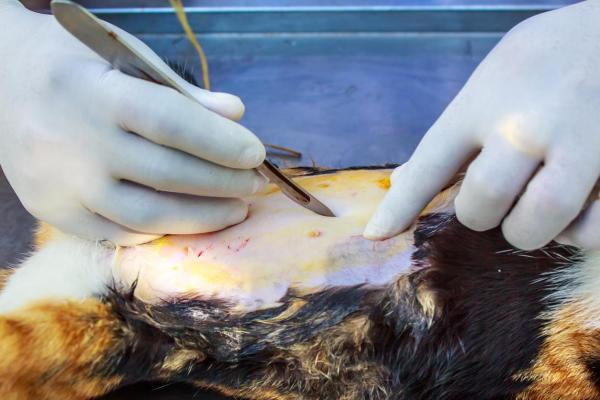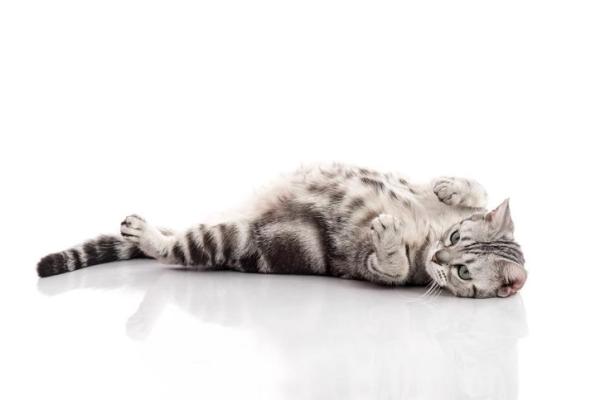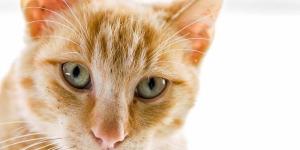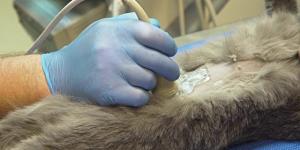C-Section in Cats Procedure and Aftercare



See files for Cats
A cesarean section in cats, also known as a c-section, is a surgical intervention which is required when a pregnant cat cannot give birth naturally. The reasons a cat cannot give birth without help are varied. They can be determined before the cat enters labor which will usually require scheduling of a cesarean section, although it may be required when complications during the cat's labor are observed. Although c-sections may be required for some cats, they are uncommon. Most pregnant cats are able to give birth without complication and will know instinctually what to do during labor.
At AnimalWised, we discover what happens when there are complications in feline labor by looking at c-section in cats procedure and aftercare. We discover in which situations a cat will need a c-section and what to expect in terms of the surgery itself.
What is a c-section procedure in cats?
A cesarean section in cats is a type of surgical intervention by which the unborn kittens are removed from their pregnant mother. This requires surgical incision into the abdominal area which provides access to the uterus. The kittens can then be extracted from the uterus without having to pass through the cat's birth canal (vagina).
Domestic cats normally give birth naturally without the need for surgical intervention. For this reason, a c-section is uncommon. In pedigree cats, a reported 8% of cat labor required c-section[1]. Purebred cats are more likely to develop genetic health conditions due to a smaller gene pool. Although there is insufficient evidence, this would imply that non-pedigree cats and mixed-breed cats are even less likely to require a c-section procedure.
Why do cats need c-sections?
The gestation period for cats lasts between 57 and 65 days. After this time, the future mother will choose a place in the home to bring her new family into the world. The majority of cats are capable of giving birth without any problem, since problems during childbirth are really rare in felines.
However, complications during parturition (labor) can result in the need for a c-section. Such complications can jeopardize the health of the mother cat, kittens or both. They can be very serious and there is potential for stillbirth or even the death of mother and/or kittens. These complications fall into two broad categories:
- Preventive treatment
- Therapeutic treatment
We define these types of c-section in cats in the sections below. We also look at the various underlying reasons cats will need each type of c-section to safeguard the health of mother and kittens.

Preventive reasons for c-section in cats
Your veterinarian may recommend a preventive cesarean section if your cat is a brachycephalic breed (such as the Persian) or with a very narrow birth canal (such as the Siamese). Another issue is when the unborn kittens are considered too large.
Brachycephaly in cats is a genetic condition which is common to certain purebred cats such as the Persian, British Shorthair and Scottish fold. These cats are distinctive due to their flat faces, a genetic trait passed on from generation to generation. This can make parturition difficult for brachycephalic cats since their respiratory system is affected and their body can have difficulty dealing with the strain.
Some breeds such as the different types of Siamese cat can have a narrower birth canal. This makes delivering the kittens difficult and may put mother and newborns at risk, hence the need for a s-section procedure.
Any cat may have kittens which are abnormally large. This can be complicated if they have a particularly large litter. A veterinarian will determine the size of the kitten shortly before the due date via ultrasound.
Such preventive reasons for a c-section in cats shows the importance of regular checkups for pregnant felines. If the veterinarian considers the risk for natural birth too great, they will schedule a preventive c-section at a time before labor, but after the kittens are sufficiently developed in utero.
Therapeutic reasons for c-section in cats
A therapeutic cesarean section is one that is performed when unexpected problems occur at the time of delivery. Although it is best to not intervene in the cat's delivery, we should observe them at a safe distance to see if any complications occur. We should provide them with a safe space with comfortable accessories to make a nest. The mother cat will choose her own nesting area, so you shouldn't move her unnecessarily.
Such complications in cat labor can include the following:
- Dystocia: this is when the cat's labor is prolonged and there are signs of difficulty in giving birth. The time it takes for a cat to give birth after labor begins is usually between 2-5 hours, although it can last up to 12 hours with no complication. After this time, the mother cat can become very weak and the longer it lasts, the more risk to her health.
- Weak contractions: especially after dystocia, it is possible the cat's contractions are so weak she is having difficult birthing her kittens. This could be due to other issues which cause muscle weakness.
- Obstructed labor: if a kitten is stuck in the birth canal, the other kittens cannot be birthed and the mother will be seriously jeopardized. This often occurs with malpresentation, i.e. the kittens are in an abnormal position which makes them become stuck.
- Disease: if a cat has contracted a disease such as a viral or bacterial infection, it can make their organism weak and cause difficult in giving birth. It also poses a threat to the kittens who can contract an infectious disease from the mother. We might see symptoms of this before the labor such as when a pregnant cat is leaking fluid.
How do you know if there is a complication in cat labor?
In principle we should not be alarmed if we observe vomiting, tremors and urine before delivery. These are normal signs that a cat is about to give birth. After the uterine and abdominal contractions, the kittens will begin to be born. The interval between kitten births is usually between 30 minutes and 2 hours, but it can be shorter or longer in some cases.
After each newborn kitten is born, the mother, the mother will have to clean them, give them warmth and cut the umbilical cord. During these preparations, we will not observe contractions. However, if we observe prolonged contractions without the birth of any kitten, we should quickly contact the veterinarian. It could be a sign of one of the complications in labor. Other signs of problems that indicate the need for this surgical operation are the presence of purulent infection, seen as greenish or black discharge.
If the cat complains, screams, appears too tired or faint, it means she needs immediate medical attention. Go to the specialist or call them to come to your home. They may determine that a c-section procedure is required.

What is the aftercare of a c-section in cats?
Performing a cesarean section procedure on a cat is considered a routine and fairly safe procedure. In the therapeutic case, its success will largely on how quickly the feline is transferred to the medical center.
Remember that cats that do not present problems during childbirth or that do not have a predisposition to suffer any problems during this process should not be candidates for a cesarean section. This procedure prevents the kittens from receiving colostrum (milk that immunizes the little ones) and it may even occur that the mother cat rejects them.
The intervention is carried out using anesthesia. In the 24 or 48 hours following, the mother's instinct kicks in to take care of her litter. Consult your veterinarian about the best way to care for newborns during this period. They will ensure you do take following steps to provide the right aftercare:
- Monitor: in case any complications from the surgical procedure arise.
- Limit activity: the mother cat will want to stay with her kittens anyway, but we should not move them unnecessarily or otherwise encourage activity.
- Nutrition: we will need to ensure we have food available for the cat when they need it. We should keep it nearby so she doesn't need to eat. Plenty of clean and fresh water is also needed.
- Feeding kittens: depending on the mother's condition it will be decided whether they should be breastfed. If not, bottle feeding the kittens wilk milk replacement formula will be necessary.
- Medication: the doctor may prescribe pain medication to manage discomfort, as well as antibiotics to reduce the risk of secondary infection. Your individual cat may also need other medications determined by the vet.
As you can see, recovery and aftercare following a c-section section is relatively simple. Follow the specialist's instructions to the letter and in a few days the cat will be the same as before. Once a cesarean section has been necessary, seriously consider sterilizing your cat. It is most likely that if it becomes pregnant again the same problems will repeat during delivery.
In some cases, spaying the cat during the c-section may be required. Learn more about the safety of spaying a pregnant cat in our related guide.

This article is purely informative. AnimalWised does not have the authority to prescribe any veterinary treatment or create a diagnosis. We invite you to take your pet to the veterinarian if they are suffering from any condition or pain.
If you want to read similar articles to C-Section in Cats Procedure and Aftercare, we recommend you visit our Pregnancy problems category.
1. Sparkes, A. H., Rogers, K., Henley, W. E., Gunn-Moore, D. A., May, J. M., Gruffydd-Jones, T. J., & Bessant, C. (2006). A questionnaire-based study of gestation, parturition and neonatal mortality in pedigree breeding cats in the UK. Journal of feline medicine and surgery, 8(3), 145–157.
https://doi.org/10.1016/j.jfms.2005.10.003







